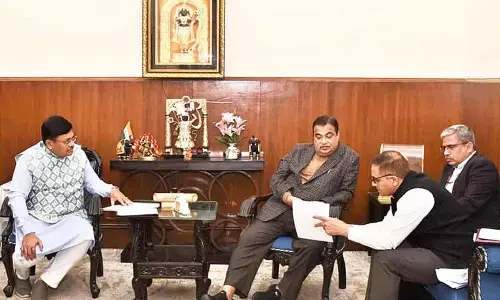RBI’s MPC keeps repo rate unchanged, warrants vigil on inflation

The repo rate has been paused at 6.50 per cent for the third successive time even though another hike in the coming months cannot be ruled out. This depends upon the evolving inflation situation in the coming quarters. However RBI is clear and committed to bring down headline inflation to the targetted level of four per cent
RBI Governor Shaktikanta Das while stating that the Monetary Policy Committee (MPC) has decided to keep the policy repo rate unchanged at 6.50 per cent, pointed out that all others like the standing deposit facility (SDF), marginal standing facility (MSG) rate and bank rate would continue to be the same.
This is the third successive time the repo rates have been paused.
According to RBI, it expected inflation to surge during July and August and estimated in their revised projections of headline inflation and accordingly projection for Q2 24 was revised upwards by more than 100 basis points from 5.2.
It is likely to remain high in Q3 24 and RBI has revised its estimation from 5.4 per cent to 5.7 per cent and Q4 24 has been kept at the earlier projected 5.2 per cent. However for the full Year FY 2024, RBI has revised upwards inflation forecast to 5.4 per cent in August from 5.1 per cent in June. In view of these developments, it could have raised the repo rate in the August meeting. This is perhaps because some moderation is expected with arrivals of fresh goods. There are indications that tomatoes are likely to be imported from Nepal.
According to Siddharth Sanyal, chief economist of Bandhan Bank, mentions “RBI justifiably refrained from any rate action immediately, even though another hike in the coming months cannot be ruled out. This depends upon the evolving inflation situation in the coming quarters”.
However RBI is clear and committed to bring down headline inflation to the targetted level of four per cent.
The RBI Governor said “I reiterate that bringing inflation within the tolerance brand is not enough; we need to firmly focuson aligning inflation to the target of four per cent.”
This statement indicates that RBI will take all policy decision on rate hike, inflation going beyond the current projections due to frequent incidences of recurring food prices shocks, increase in global commodities prices and further risk in geo political situations.
Due to the return of Rs 2000 notes, RBI’s surplus to the government, pick up in government spending and capital funds have resulted in surplus liquidity in the system. The overall daily absorption under the liquid adjustment facility(LAF) had also gone up from Rs 1.7 lakh crore in June to Rs 1.8 lakh crore in July.
Meanwhile, there has been a lukewarm response to RBI variable rate reverse repo (VRRR) auctions. Any excess liquidity over and above what is adequate to meet the productive requirements of the economy, may lead to price rise and pose risk to price stability. As a means to impound the excess liquidity, the central bank announced that “with effect from the fortnight beginning on August12, scheduled commercial banks shall maintain an incremental cash reserve ratio (CRR) of 10 per cent in the increase in their net demand and time liabilities (NDTL) between May 19 and July 28. This action on CRR may take away more than Rs one trillion of liquidity from the system for the next two fortnights. The RBI will review the same on September8.
As regards the GDP growth, it has retained its forecast of GDP growth for FY 24 at 6.5%, as projected in the June meeting.
There has not been any major change in the quarter-wise projections for Q1, Q2,Q3 and Q4 projections at 8%, 6.5%, 6.0%,and 5.7%, respectively. RBI has continued with the projected 6.5% growth, as there is strong urban demand and pick up in rural demand along with uptick in industrial activity. However the latest industrial growth is below expectation in June, easing to a three-month low of 3.7%, as per data released on Friday as against the industrial production of 5.3% in May.
The International Monetary Fund (IMF) recently revised India’s GDP growth forecast to 6.1% for 2023, up from 5.9% projected by the financial institution earlier this year because of ‘stronger domestic investment’. However it maintained its forecast for 2024 at 6.3%.
Fitch ratings raised its FY24 growth forecast for the Indian economy at 6.3% from the 6% predicted earlier. The World Bank, in its India Development Update, revised i’s FY23/24 forecast to 6.3% from 6.6 per cent projected last December.
“Indian economy continues to show strong resilience to external shocks. Notwithstanding external pressures, India’s service exports have continued to increaseand the current account deficit is narrowing,” said Auguste Tano Kouame, World Bank’s Country Director in India.
Purchasing Manager’s Index (PMI)for manufacturing was 57.7 in July while PMI for services rose to 62.3 in July from 58.5 a month before. The Centre’s capital expenditure has increased by 59.1 per cent (y-o-y) in Q1 2023-24. There has been a revival in capex in certain sectorslike metals, petroleum, automobile, chemicals, iron and steel, cement and food and beverages. Capacity utilisation in the manufacturing sector at 76.3 per cent (and 74.1 per cent on seasonally adjusted basis) remained above the long-term average of 73.7 per cent. There has been enhanced flow of resources to commercial sector from banks and other sources taken together at Rs 7.5 lakh crore during this financial year so far upto July 28 as compared with Rs 5.7 lakh crore a year ago. All these data indicators point out towards momentum and drivers for strong GDP growth in Indian economy.
Hence RBI has kept its forecast GDP growth at 6.5 per cent for 2023-24.
The RBI Monetary Policy has also some additional measures like review of Regulatory Framework for Financial Benchmark Administrators, review of Regulatory Framework for Infrastructure Debt Fund- NBFCs ( IDF- NBFCs), Greater Transparency in Interest Rate Reset of EMI-based floating interest loans, conversational payments and off-line capability on UPI; enhancement of transaction limit of small value off-line digital payments andpublic tech platform for frictionless credit.
The central bank has prescribed a framework to be implemented by all regulated entities to address issues faced by the housing loan borrowers. It would augur well if clearly communicates with borrowers for resetting the tenor and/or EMI, provide options for switching to fixed rate loans or foreclosure of loans, transparent disclosure of various charges incidental to exercise these options.
Apparently, the bank has now considered the pain borrowers face with regard to floating rate loans without realising interest rate risk, particularly in the current period.
With increase in WADTDR on fresh deposits and WALR on fresh loans at 231 basis points and 169 basis points, respectively, there may be further passing of interest on loans as full transmission is yet to take place. As and when deposit costs go up, banks will be forced to increase the lending rates. Recently some banks increased their lending rates by 10 basis points. Borrowers have to calculatewhen contracting retail loans with floating/or fixed rate loans. Such a transparent and proper disclosure is a theright step for the borrowers, who should also be appraised of the options.

















